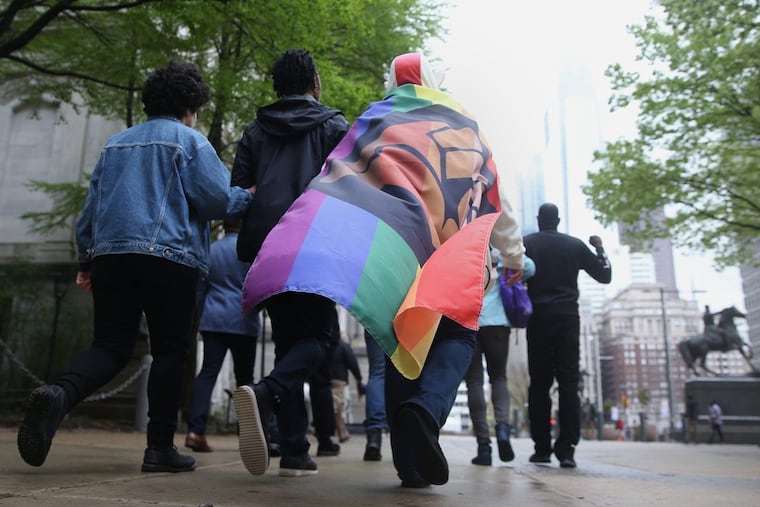Philadelphia’s mental health systems are failing LGBTQ kids | Opinion
Changing policies on emergency contacts, pronouns, and gender-inclusive language can help.

The COVID-19 pandemic has created, in its wake, a mental health crisis that is disproportionately impacting young Americans. The psychological impacts are unique for LGBTQ youth, who already experience marginalization and discrimination. For nearly two years, LGBTQ kids in Pennsylvania have been isolated in their homes, many of which do not honor or reflect their identities.
Representation matters and often comes in the form of community. It is commonly outside of the home that LGBTQ kids are able to connect with resources that affirm their sense of self. Without seeing the possibility of themselves in others, it’s easy to feel invisible and that living one’s truth is impossible. In the worst cases, this can escalate to suicidal ideation.
Right now, Philadelphia’s mental health systems are failing LGBTQ youth. In 2021, the American Academy of Pediatrics declared a state of emergency in children’s mental health nationwide, but resources in our city to respond to this emergency are at best limited and at worst actively harmful to the kids who need mental health support the most.
Waiting lists for outpatient care — once-a-week therapy for 50-minute sessions — range from four to nine months citywide. Many local therapists are full, and few are able to accept health insurance. And this is only at the most basic level of the system. Higher levels of care are mired in chaos and long wait times.
As the founder and owner of Walnut Psychotherapy Center, an outpatient mental health practice that sees around 420 LGBTQ patients in Philadelphia, I have seen this crisis firsthand. Before the pandemic, we received between 15-20 inquiries per week. Now, we receive 20-35 inquiries per week, only one to two of which we’re able to accept. Our wait list for telehealth appointments is five months long. In order to accept a client, everything has to perfectly align with health insurance and therapists’ schedules. This is harder with kids because they have to be seen after school and there are only so many hours in the day. Often, the people who reach out to us need a higher level of care than what once-a-week therapy can provide.
The responsible thing to do is to refer a client to another mental health clinic. Our clients tell us that they’ve called Mazzoni Center and Therapy Center of Philadelphia, but there’s no immediate availability. For Black and brown LGBTQ clients seeking a therapist who can affirm and understand the intersectionality of their identities, wait times are even longer.
At the end of 2021, we interfaced with a white 12-year-old client who was acutely suicidal. My team referred them to a local ER. The child went to Children’s Hospital of Philadelphia where they spent nearly 72 hours in the waiting room. They finally received a bed at CHOP and remained there for eight days for stabilization, not treatment.
While an emergency room offers the possibility of stabilization, it is not specifically designed to treat mental health. There are a few alternatives — Friends Hospital, Belmont Behavioral Health System, and the Horsham Clinic — but beds are rarely open. Many practitioners in these settings are not specifically trained in LGBTQ-affirming care.
The mental health of LGBTQ youth in the COVID-19 pandemic is a large and systemic problem, but there are small changes that can help. Electronic medical records are part of every medical interaction. In many cases, the software excludes trans and nonbinary gender identities. A shift to gender-inclusive language on paperwork would at least let the client sit down and think: I don’t have to defend my existence at this moment.
Every mental health practitioner should introduce themselves with their pronouns to normalize this practice and invite the gender expansiveness of their clients.
We need to stop asking clients what their “preferred” name is. Their name is not preferred, it is just their name. Labeling it as preferred leaves the client feeling like they are opting in to their identity, rather than that their identity exists as fact.
Every inpatient setting needs to have rooms that are designated for LGBTQ people who do not fit within the gender binary.
Lastly, one of the largest triggers for members of the LGBTQ community when entering any medical practice is the request for an emergency contact. While superficially this is a benign ask, the isolation that accompanies living in a queer identity often makes access to an emergency contact impossible. There are agencies and peer networks that can serve this need rather than reiterating the aloneness of the client in the world.
The needs are deeper than these ideas suggest, but they are starting places. The youngest members of the LGBTQ community are experiencing the mental health crisis acutely. We owe it to them to do better.
Danna Bodenheimer is the founder of Walnut Psychotherapy Center, a mental health practice that sees around 420 LGBTQ people in Philadelphia.
If you or someone you know is thinking of suicide, call the National Suicide Prevention Lifeline at 1-800-273-8255 or text TALK to the Crisis Text Line at 741741. The Disaster Distress Helpline, 1-800-985-5990, is also providing immediate counseling to anyone who is seeking help in coping with the mental or emotional effects of the coronavirus pandemic.